Abstract
1. To examine the influence of the rate of heat loss on the magnitude of post-exercise hypotension, subjects were exposed to three different environmental conditions during recovery from bicycle exercise. 2. When subjects recovered in warm conditions both core temperature (measured in the external auditory meatus) and mean skin temperature were significantly elevated 60 min after the cessation of exercise. This attenuation of heat loss was associated with a significant reduction in post-exercise mean arterial pressure. 3. In contrast, when subjects recovered in neutral or cool conditions both core temperature and mean arterial pressure had returned to baseline levels 60 min after exercise. 4. These results indicate that persistence of peripheral vasodilatation during recovery from exercise, and therefore the magnitude of post-exercise hypotension, is dependent upon thermoregulatory-induced changes in skin blood flow.
Full text
PDF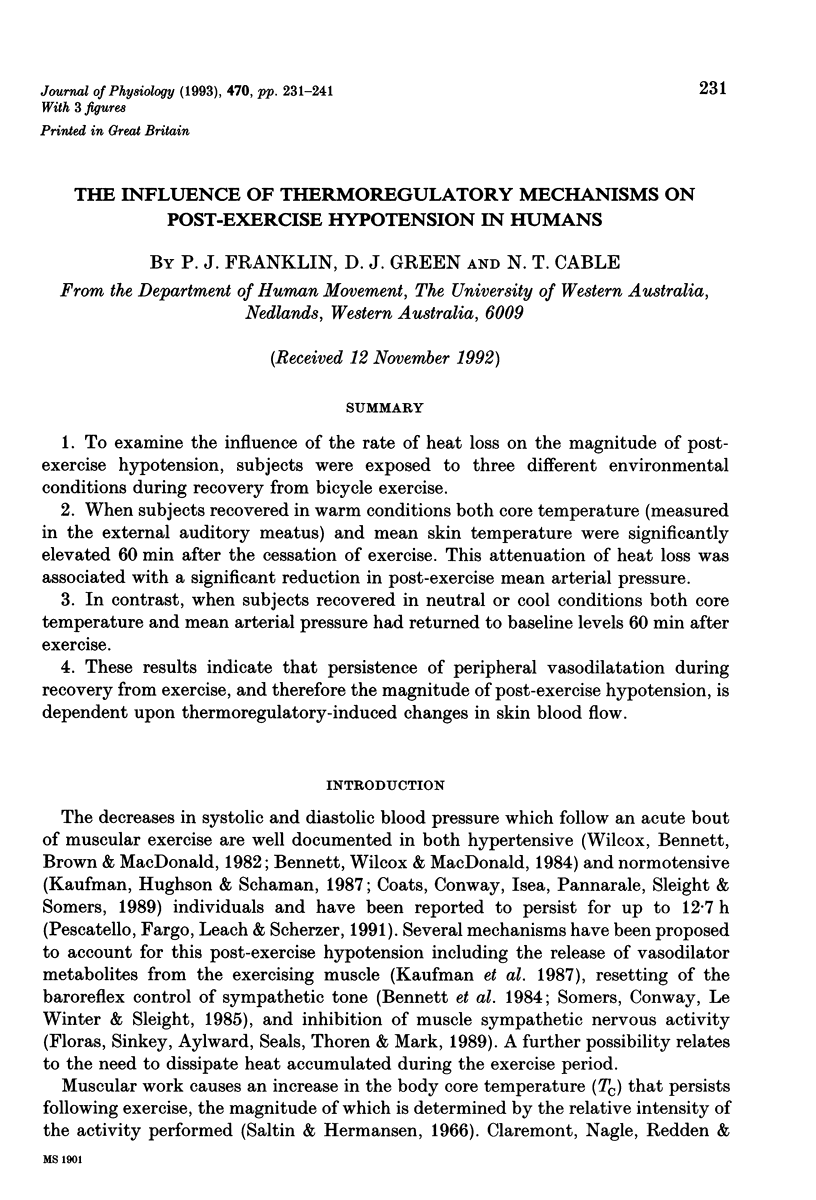
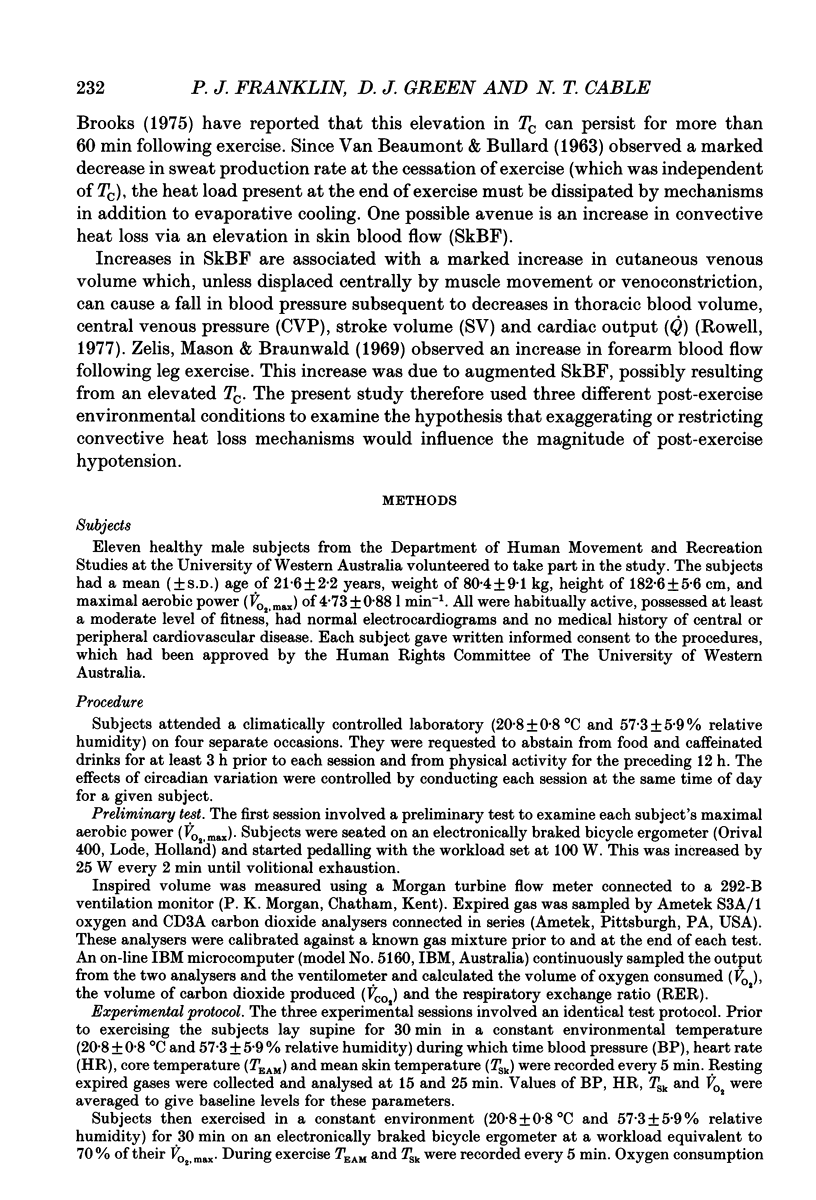
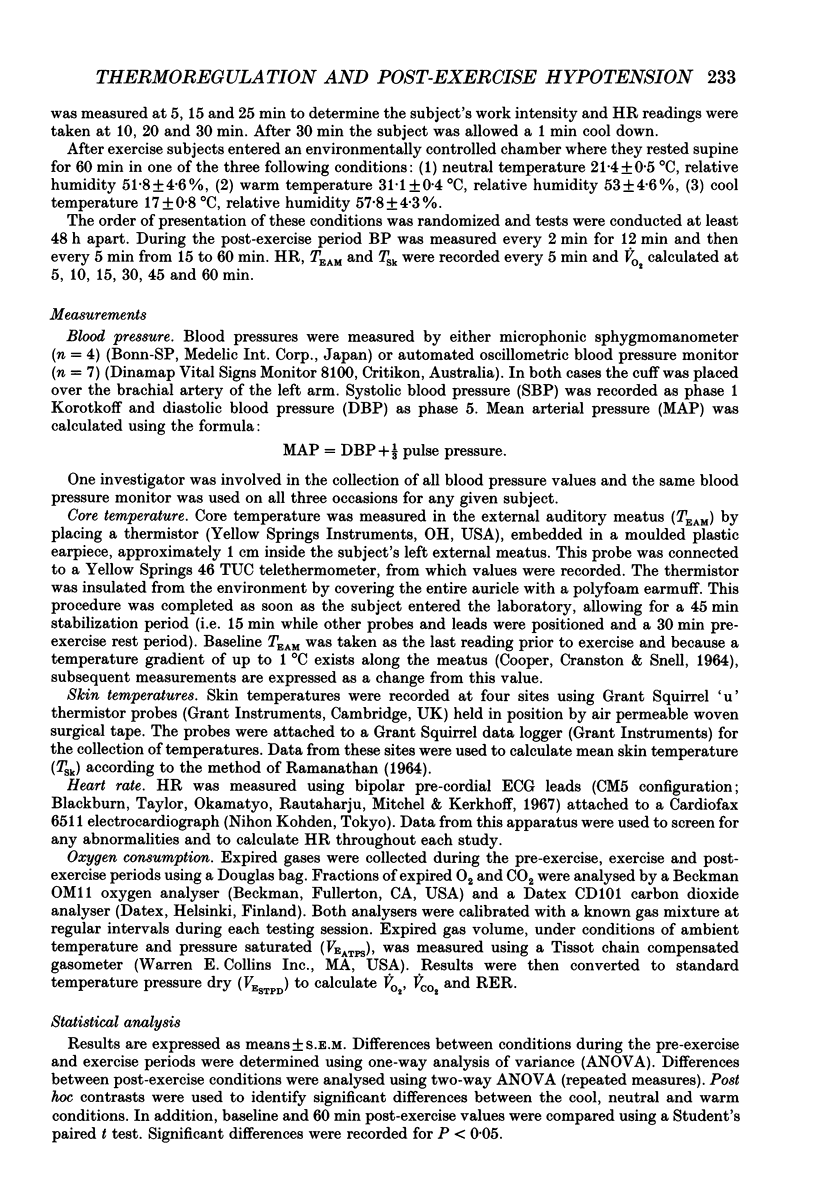
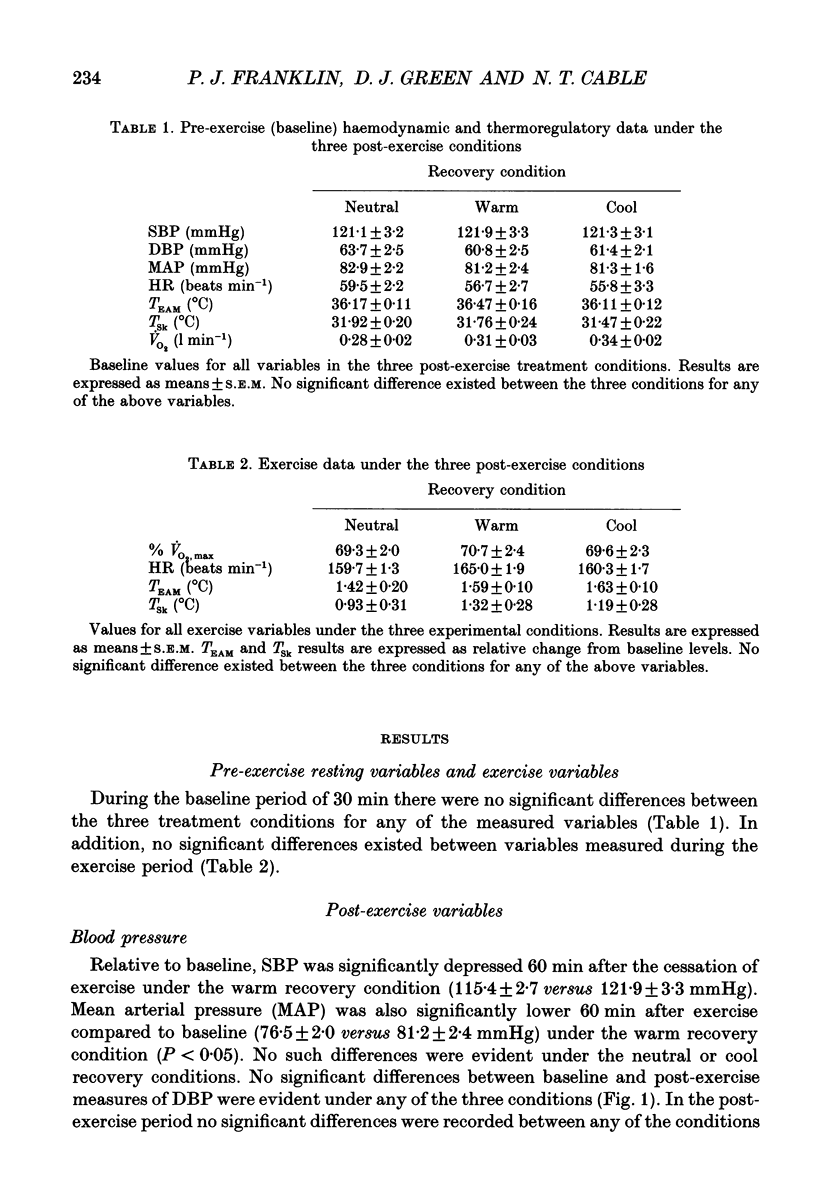
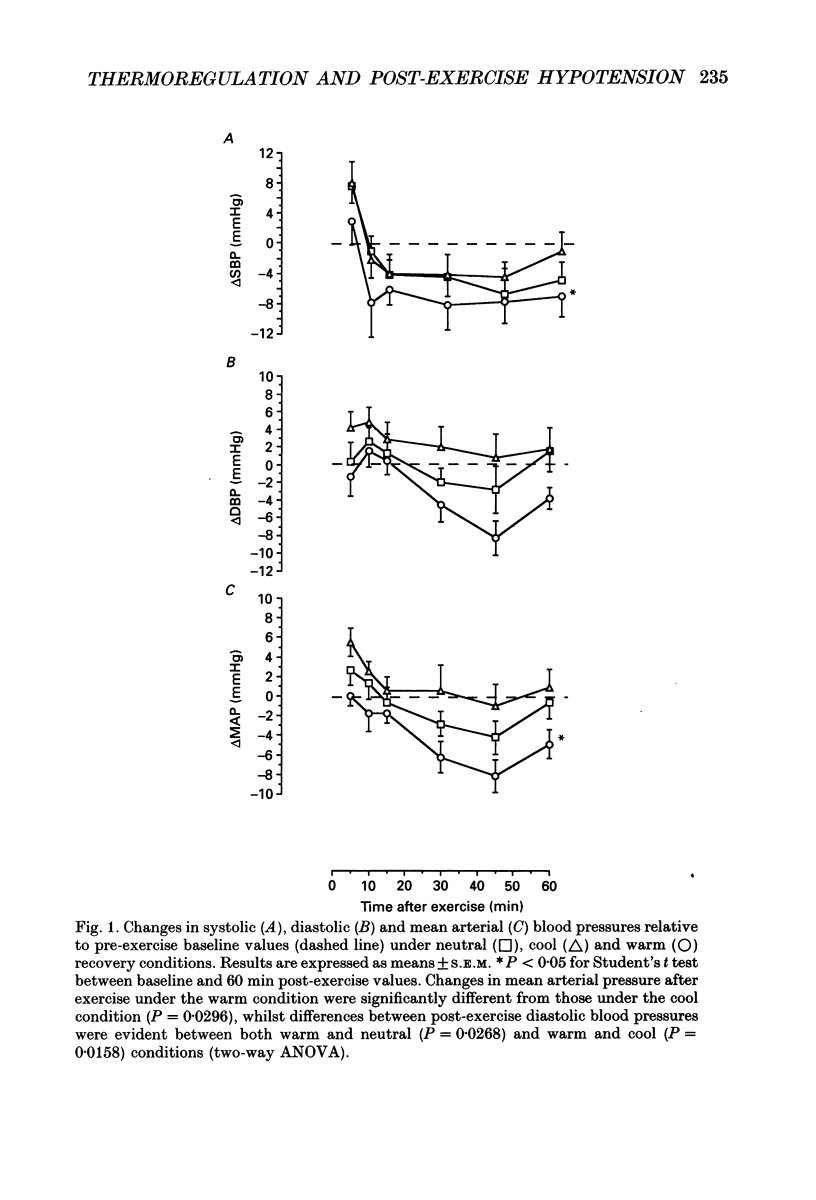
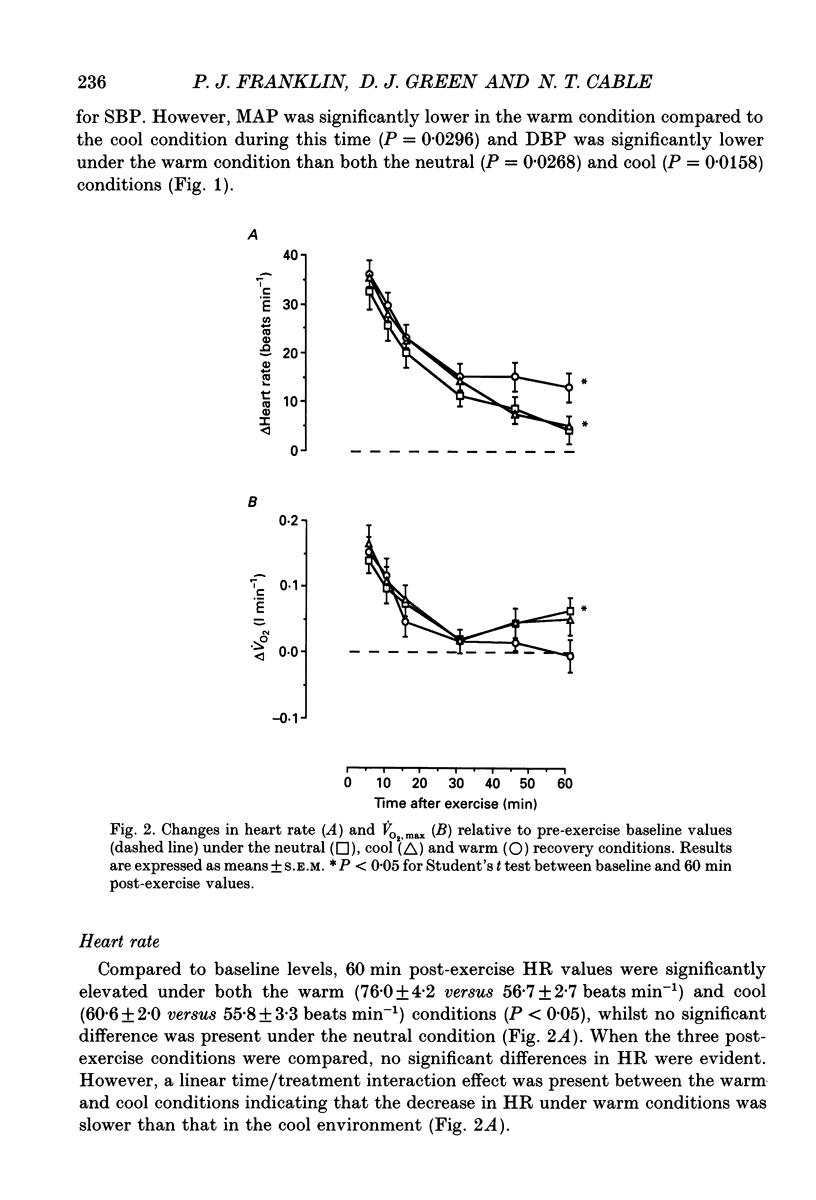
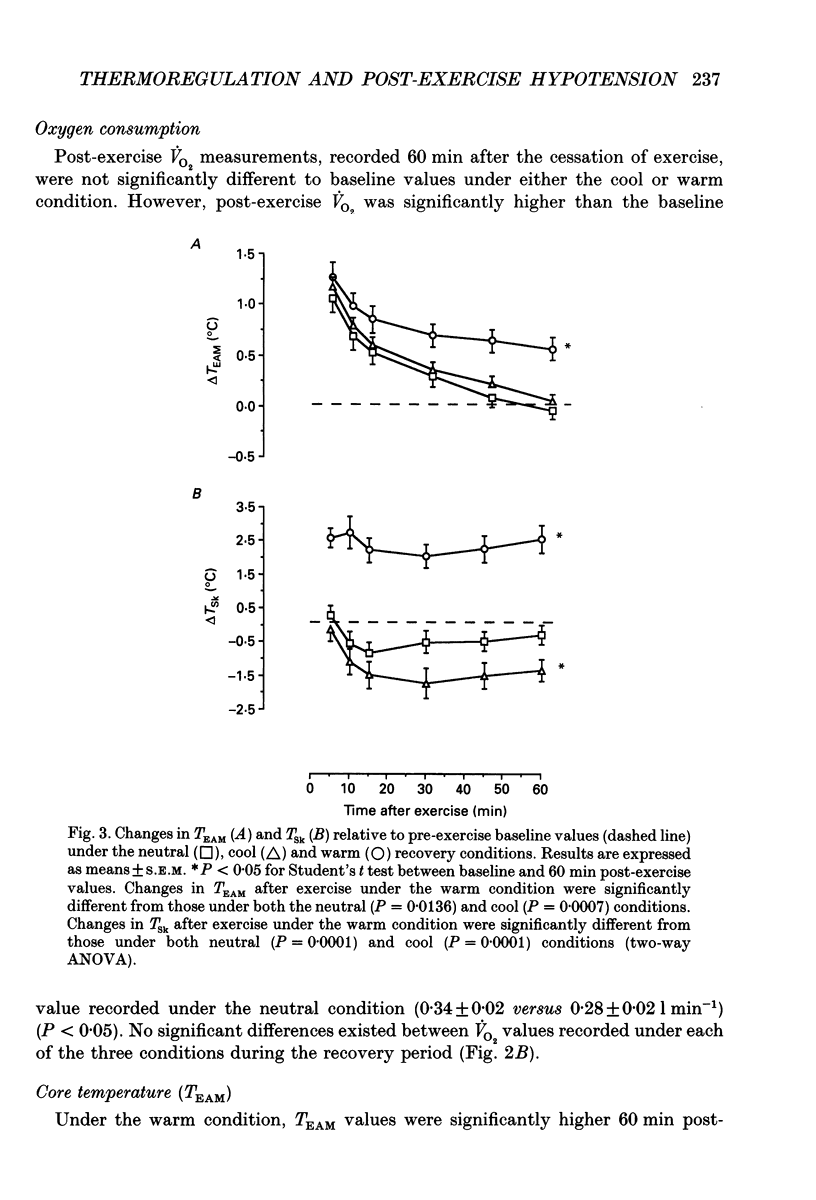
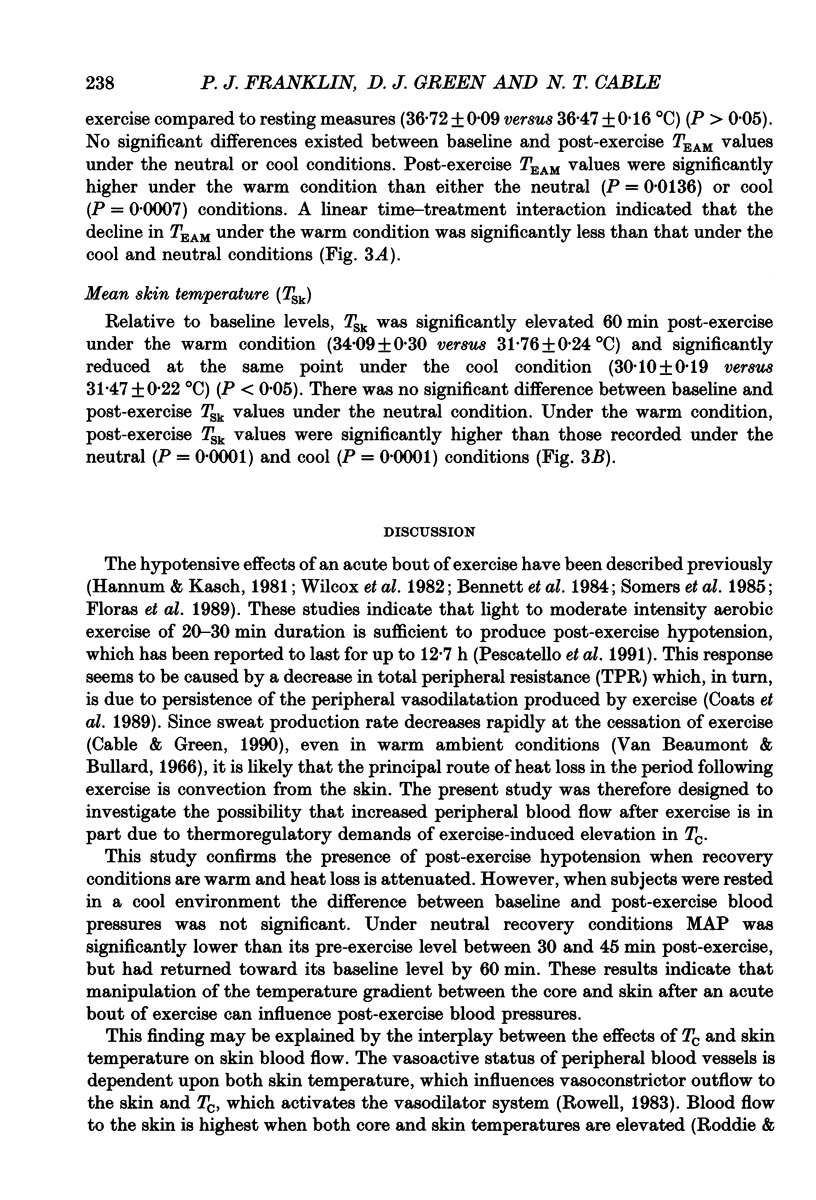
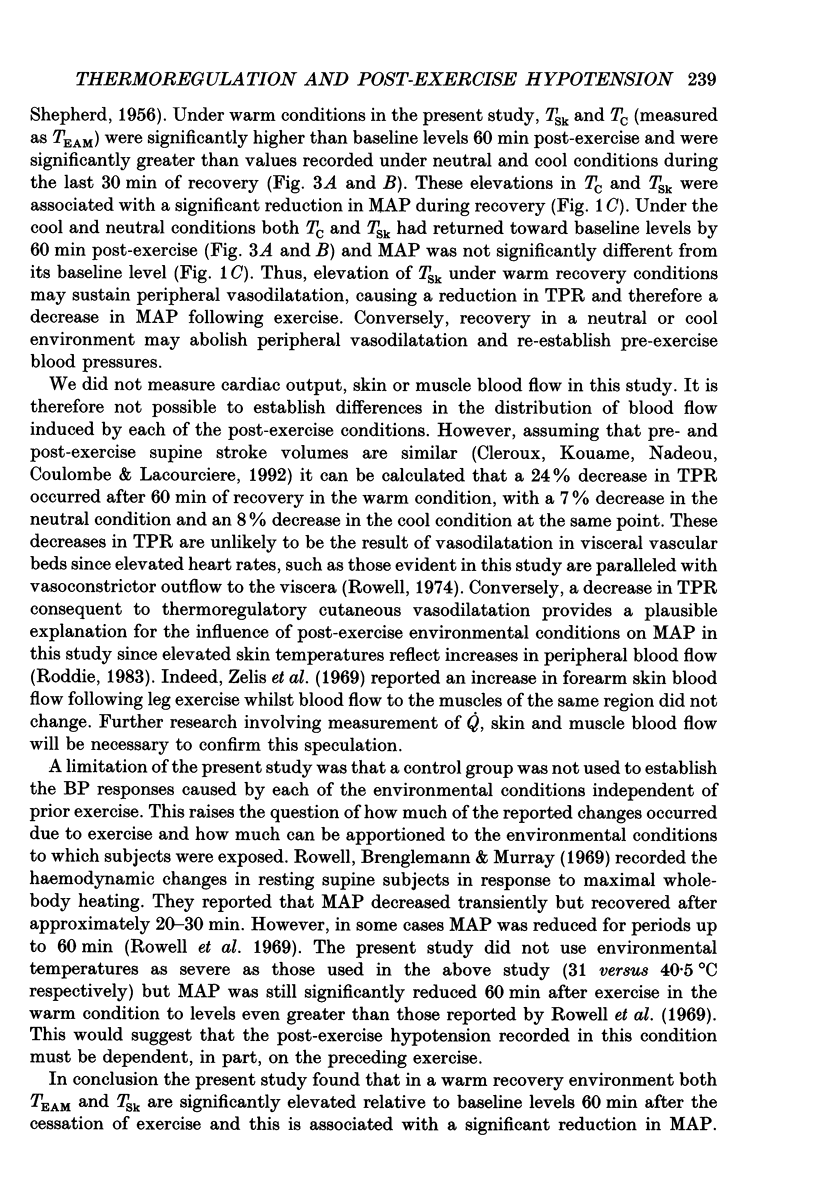
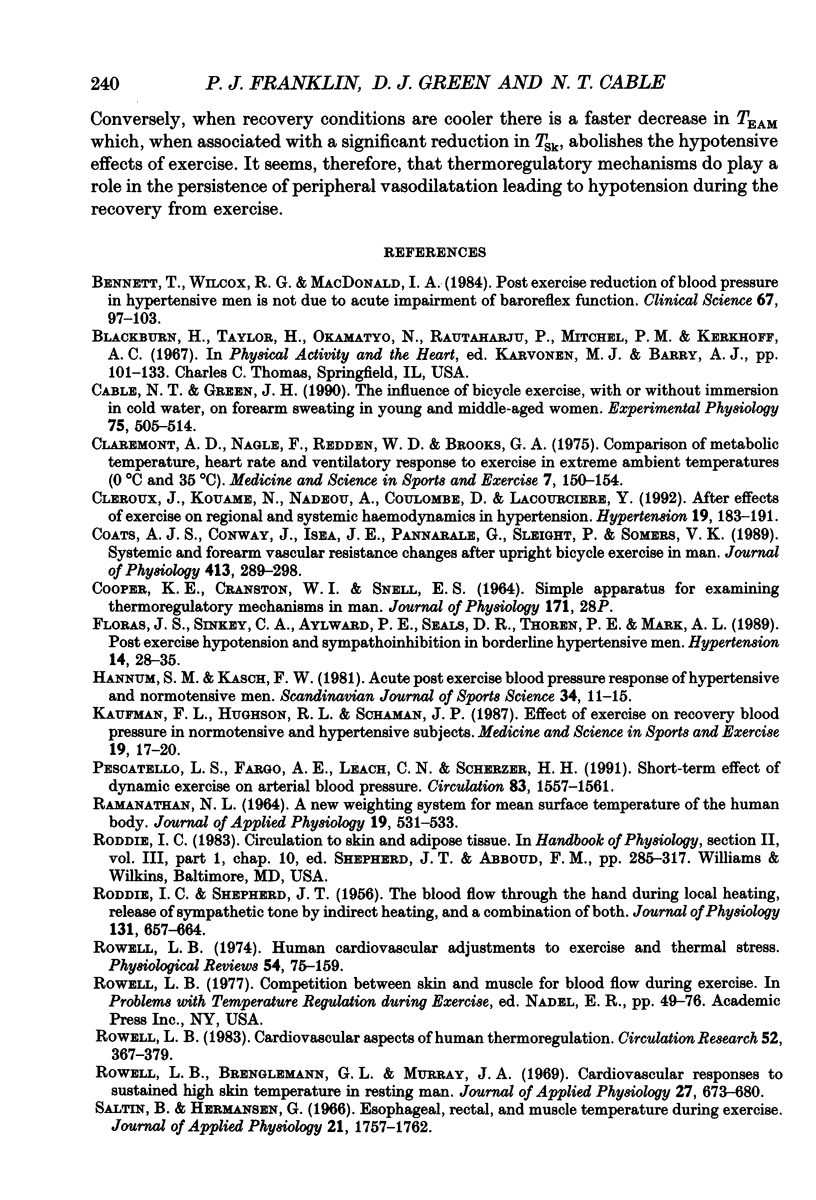
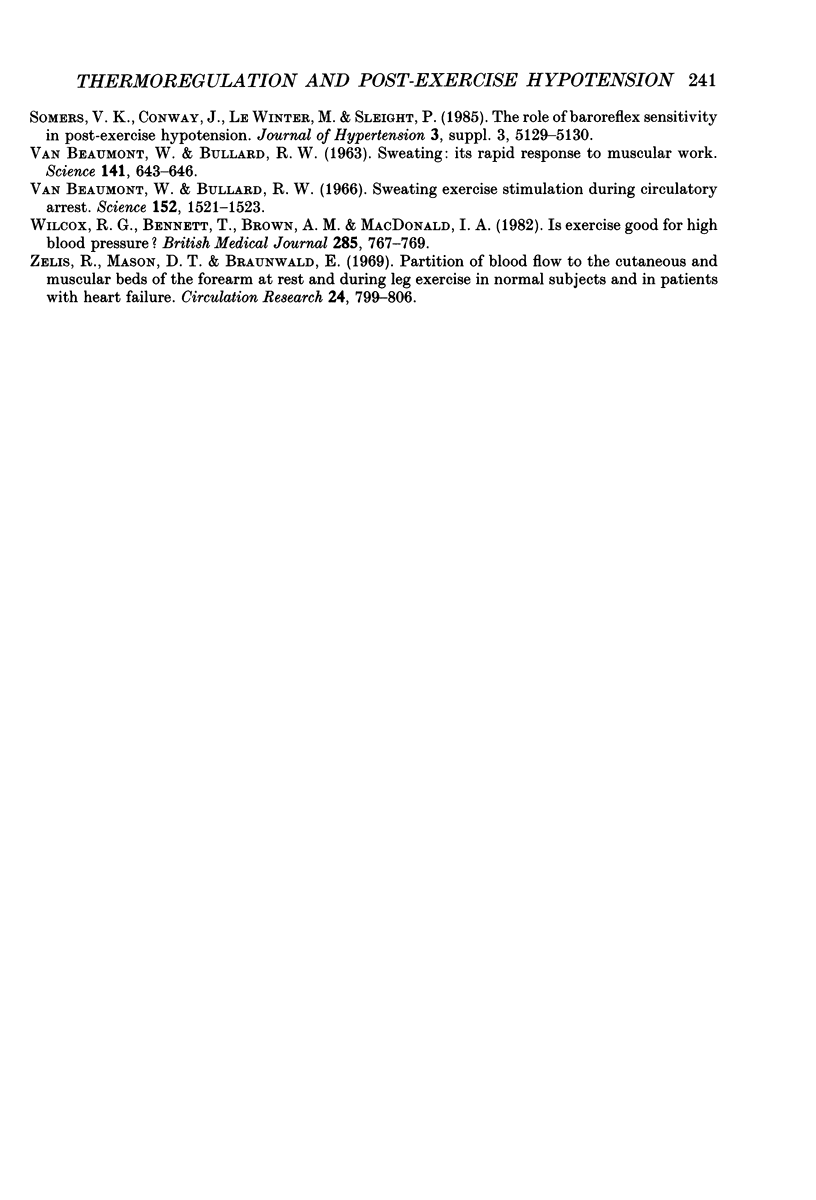
Selected References
These references are in PubMed. This may not be the complete list of references from this article.
- Bennett T., Wilcox R. G., Macdonald I. A. Post-exercise reduction of blood pressure in hypertensive men is not due to acute impairment of baroreflex function. Clin Sci (Lond) 1984 Jul;67(1):97–103. doi: 10.1042/cs0670097. [DOI] [PubMed] [Google Scholar]
- Cable N. T., Green J. H. The influence of bicycle exercise, with or without hand immersion in cold water, on forearm sweating in young and middle-aged women. Exp Physiol. 1990 Jul;75(4):505–514. doi: 10.1113/expphysiol.1990.sp003427. [DOI] [PubMed] [Google Scholar]
- Claremont A. D., Nagle F., Reddan W. D., Brooks G. A. Comparison of metabolic, temperature, heart rate and ventilatory responses to exercise at extreme ambient temperatures (0 degrees and 35 degrees C.). Med Sci Sports. 1975 Summer;7(2):150–154. doi: 10.1249/00005768-197500720-00027. [DOI] [PubMed] [Google Scholar]
- Cléroux J., Kouamé N., Nadeau A., Coulombe D., Lacourcière Y. Aftereffects of exercise on regional and systemic hemodynamics in hypertension. Hypertension. 1992 Feb;19(2):183–191. doi: 10.1161/01.hyp.19.2.183. [DOI] [PubMed] [Google Scholar]
- Coats A. J., Conway J., Isea J. E., Pannarale G., Sleight P., Somers V. K. Systemic and forearm vascular resistance changes after upright bicycle exercise in man. J Physiol. 1989 Jun;413:289–298. doi: 10.1113/jphysiol.1989.sp017654. [DOI] [PMC free article] [PubMed] [Google Scholar]
- Floras J. S., Sinkey C. A., Aylward P. E., Seals D. R., Thoren P. N., Mark A. L. Postexercise hypotension and sympathoinhibition in borderline hypertensive men. Hypertension. 1989 Jul;14(1):28–35. doi: 10.1161/01.hyp.14.1.28. [DOI] [PubMed] [Google Scholar]
- Kaufman F. L., Hughson R. L., Schaman J. P. Effect of exercise on recovery blood pressure in normotensive and hypertensive subjects. Med Sci Sports Exerc. 1987 Feb;19(1):17–20. [PubMed] [Google Scholar]
- Pescatello L. S., Fargo A. E., Leach C. N., Jr, Scherzer H. H. Short-term effect of dynamic exercise on arterial blood pressure. Circulation. 1991 May;83(5):1557–1561. doi: 10.1161/01.cir.83.5.1557. [DOI] [PubMed] [Google Scholar]
- RAMANATHAN N. L. A NEW WEIGHTING SYSTEM FOR MEAN SURFACE TEMPERATURE OF THE HUMAN BODY. J Appl Physiol. 1964 May;19:531–533. doi: 10.1152/jappl.1964.19.3.531. [DOI] [PubMed] [Google Scholar]
- RODDIE I. C., SHEPHERD J. T. The blood flow through the hand during local heating, release of sympathetic vasomotor tone by indirect heating, and a combination of both. J Physiol. 1956 Mar 28;131(3):657–664. doi: 10.1113/jphysiol.1956.sp005490. [DOI] [PMC free article] [PubMed] [Google Scholar]
- Rowell L. B., Brengelmann G. L., Murray J. A. Cardiovascular responses to sustained high skin temperature in resting man. J Appl Physiol. 1969 Nov;27(5):673–680. doi: 10.1152/jappl.1969.27.5.673. [DOI] [PubMed] [Google Scholar]
- Rowell L. B. Cardiovascular aspects of human thermoregulation. Circ Res. 1983 Apr;52(4):367–379. doi: 10.1161/01.res.52.4.367. [DOI] [PubMed] [Google Scholar]
- Rowell L. B. Human cardiovascular adjustments to exercise and thermal stress. Physiol Rev. 1974 Jan;54(1):75–159. doi: 10.1152/physrev.1974.54.1.75. [DOI] [PubMed] [Google Scholar]
- Saltin B., Hermansen L. Esophageal, rectal, and muscle temperature during exercise. J Appl Physiol. 1966 Nov;21(6):1757–1762. doi: 10.1152/jappl.1966.21.6.1757. [DOI] [PubMed] [Google Scholar]
- VAN BEAUMONT W., BULLARD R. W. Sweating: its rapid response to muscular work. Science. 1963 Aug 16;141(3581):643–646. doi: 10.1126/science.141.3581.643. [DOI] [PubMed] [Google Scholar]
- Van Beaumont W., Bullard R. W. Sweating exercise stimulation during circulatory arrest. Science. 1966 Jun 10;152(3728):1521–1523. doi: 10.1126/science.152.3728.1521. [DOI] [PubMed] [Google Scholar]
- Wilcox R. G., Bennett T., Brown A. M., Macdonald I. A. Is exercise good for high blood pressure? Br Med J (Clin Res Ed) 1982 Sep 18;285(6344):767–769. doi: 10.1136/bmj.285.6344.767. [DOI] [PMC free article] [PubMed] [Google Scholar]
- Zelis R., Mason D. T., Braunwald E. Partition of blood flow to the cutaneous and muscular beds of the forearm at rest and during leg exercise in normal subjects and in patients with heart failure. Circ Res. 1969 Jun;24(6):799–806. doi: 10.1161/01.res.24.6.799. [DOI] [PubMed] [Google Scholar]


